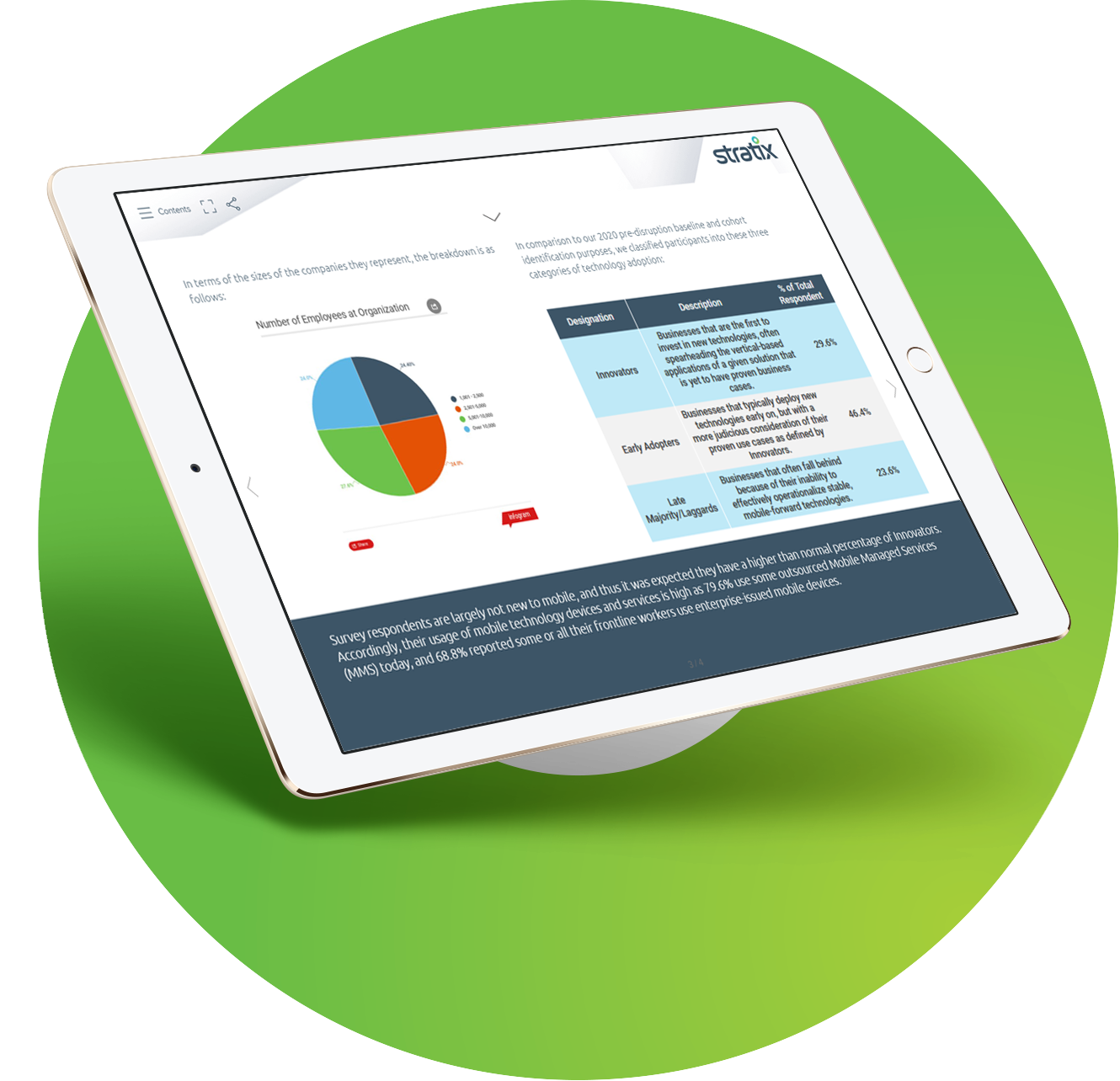Bridging the Enterprise ‘Digital Divide’ With Operational Flexibility and Smart Partnerships
Written by Elizabeth Klingseisen
3 Min Read
Blog
A Look at the ‘2021 Enterprise Mobility Outlook’ Survey
Last year, Stratix partnered with VDC Research on the “2030 Enterprise Mobility Outlook.” It was our first large enterprise mobility survey and included a look at what proved to be a prescient topic: enterprises’ strategies to avoid and weather disruption through 2030.
Soon after we published the paper, an unprecedented disruption struck in the form of the COVID-19 pandemic. Subsequently, this year, Stratix and VDC decided the time was right to partner again on a new survey to see if our findings held true.
This time around, we explored timely questions like:
- What level of disruption did organizations face?
- What strategies did they use to adapt in response?
- How has the pandemic changed their long-term technological priorities?
- What has changed in terms of how their frontline employees engage with customers and in how they invest in and manage the mobile ecosystem?
In a recent podcast, Elizabeth Klingseisen, Senior Vice President of Marketing at Stratix, discussed the key survey results and compared this year’s survey with last year’s. Here are some of the highlights.
A Look at Survey Respondents
Respondents from 250 mid-sized to large North American-based companies completed the survey. A wide range of industries were represented, including retail, manufacturing, transportation, logistics and healthcare. By design, the companies were highly mobile-oriented.
“48% of [participants] were from IT, 20% were from operations and 30% from executive management,” Klingseisen added. “That was really a conscious decision on our part because we wanted to exclude those organizational roles that were not involved in IT strategy or initiatives through the pandemic.”
Gauging Preparedness and Response
By asking certain qualifying questions, we were able to place organizations into three buckets in terms of mobile maturity:
- Innovators (the first to invest in new technologies)
- Early adopters
- Late majority (laggards)
As was the case last year, there was an uneven distribution across these three categories. We analyzed the data to see what level of mobile maturity affected pandemic preparedness and response.
“There were two categories that responded best,” Klingseisen said. “The first is innovators. They have a very high level of mobile maturity and employ very effective strategies. We had predicted this in 2020 because of their high investment in technology, high investment in partnering and strategies for having their frontline workers be very mobile and tech-enabled.”
The second group that fared well came as more of a surprise: organizations that outsource their managed mobile services.
“More than 15% of those who outsource their managed mobile services reported no revenue impact from COVID-19,” Klingseisen noted. “Only 9.8% of those who didn’t use managed mobile services saw relatively little impact on their planned revenue. That’s a really big difference in our calculation.”
Strategies for Success
In response to what pandemic-related strategies they employed, the survey found that:
- Nearly 70% of organizations moved employees to work from home.
- Over 50% invested in more mobile technology.
- 40% added net new mobile programs.
“When we extrapolate these results across all those organizations whose revenue decreased, stayed the same or increased, another interesting profile emerges,” Klingseisen said. “Those who fared better through the disruption were almost twice as likely to invest in those three strategies [as those who did not].”
The state of their IT infrastructure provided a clear delineation between the haves and the have-nots.
“The stronger their IT infrastructure, the better developed their programs and backbone, the more flexible the organization was,” Klingseisen said. “Those who responded well [to the pandemic] said their IT infrastructure investment in programs and process was one of the reasons they were so capable of adapting, while those who lacked the flexible technology infrastructure said it was their number one barrier.”
The data showed that pace of investment in mobile technology and strategies is another important variable. 60% of innovators have embraced “aggressive acceleration” of their mobile investment. This figure stood at 25.9% for early adopters and just 13.3% for laggards.
“An enterprise digital divide is emerging between those agile organizations with the mobile technology capabilities to adapt and thrive and those who have yet to wholeheartedly prioritize [and] invest,” Klingseisen concluded. “I really think that divide is real.”
Other Key Takeaways
What else stands out about the survey data? Klingseisen pointed to three areas particularly worthy of organizations’ attention:
- Flexibility: “Those organizations that have the infrastructure and mobile devices and technology in place … were best able to truly provide effective support for their operations through disruption,” Klingseisen offered. “And [now] they’re starting to experience aggressive investment and growth.”
- A focus on frontline employees: This includes equipping workers with the necessary mobile technology and support, tools to enhance collaboration, productivity and efficiency, and training to ensure a consistent customer experience. “The new landscape … is mobile-centric, if not mobile-first, with organizations investing really aggressively in the devices and tools that their frontline workers need,” Klingseisen said.
- Setting appropriate investment priorities: The pandemic sparked a dramatic shift toward mobile-first and even mobile-only technology investments. These changes are very complex in nature, making them potentially more expensive to manage. Since innovative organizations are more likely to partner to solve these challenges, Klingseisen said, “It’ll be really interesting to see how the late majority struggle to catch up.”
It’s clear that a combination of innovative planning and expert IT partners well-versed in technology deployments and support for mobile workforces is a must-have to navigate and bridge the “digital divide” that sets successful enterprises apart. For more on how mobile-first strategies have helped enterprises thrive amidst disruption, download the “2021 Enterprise Mobility Outlook.“

2021 Enterprise Mobility Outlook
Stratix and VDC Research surveyed hundreds of IT decision-makers to see how they adapted and thrived amidst disruption through mobile first strategies.
Get the Report













